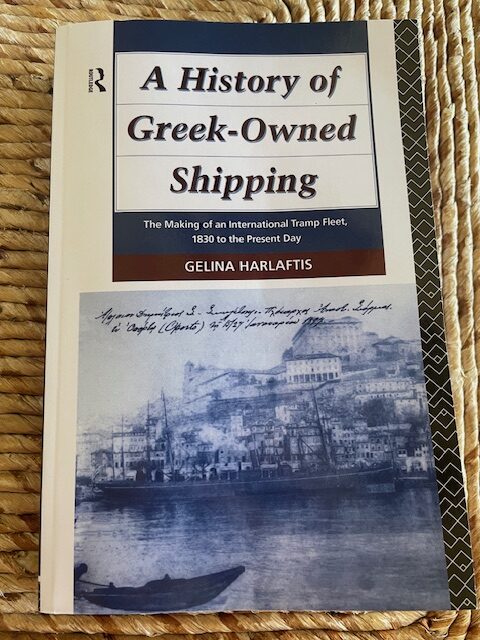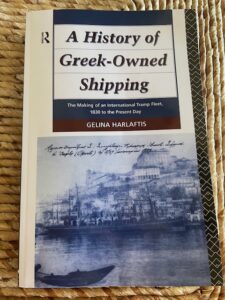“The Second World War generated not only large profits for the Greeks, but also unprecedented opportunities. The final decline of British hegemony was paralleled by the rise of the United States, traditionally a weak maritime power. Since they were unable or unwilling to operate a dominant fleet, the Americans invented a US controlled flag of convenience fleet. For various reasons, Greeks were able to profit more than other traditional maritime nations from this innovation. During the 1940s and 1950s, the flag of convenience fleet was owned mainly by Greeks and Americans. Coupled with the inexpensive purchase of a large number of war-built Liberty ships and an aggressive entrance into tankers, Greeks were able to expand their fleet more or less continuously. The 1940s and 1950s were also marked by a transfer of operations from the Eastern Mediterranean to London and New York. This created several problems with the Greek state, particularly during the 1940s.”— A History of Greek-Owned Shipping
BY STAS MARGARONIS
Introduction
Recently, Costis Frangoulis, President of the Propeller Club of Piraeus provided an update on the rebirth of Greek shipping after World War II: “At the end of the war we found ourselves with only 130 ships and in ninth place in the world ranking. Essentially, during that period the restart of our shipping began. We have to specifically single out 5 Greek shipping groups: Stavros Niarchos, Stavros Livanos, Aristotle Onassis, Petros Goulandris Sons and Rethymni-Kulukundis, because in that period and out of a total of 65 groups, these Big 5 made 40 % of total newbuild orders. These five groups created the conditions for the next day of our shipping. Both Niarchos and Onassis were the ones who stood out with the rapid and enormous development of their fleets. They were international innovators and pioneers both with the adoption of flags of opportunity – the Niarchos of Liberia and Onassis of Panama – the invention of supertankers, while also introducing a new type of financing of up to 100% of their new constructions, with long-term charters that they secured and deposited as collateral with banks. In general, their very high social visibility at an international level, combined with their enormous business work inside and outside Greece, inspired and gave a significant boost to Greek shipping, capable of reaching the top in the early 1980s”
Frangoulis pointed out that in the period 1948-2000, Greece: “built a ship every 8 days, while from 2000 to today the Greeks build a ship every 3 days which is equivalent to 100 ships a year, creating a modern fleet today with an average age of 10 years – age under than the global average. These facts also dispel the myth that the Greeks have always had a limited shipbuilding activity. Let’s also not forget that the Greek shipowners started the new constructions in the Japanese shipyards very early, only in 1952 and twenty years later in the Korean ones and in fact the shipbuilding giant Hyundai started its activities in 1972 with the orders of the two VLCCs of Georgios Stavros Livanos.”
Costis Frangoulis
A History of Greek-Owned Shipping
The leadership role that Greeks have played in shipping owes a lot to family and kinship according to Gelina Harlaftis recounts in her detailed history of Greek shipping that covers the period from Greek independence to the end of the 20th Century. Harlaftis is the Director of the Institute for Mediterranean Studies of the Foundation of Research and Technology-Hellas (FORTH). Most recently, in 2019, she authored Creating Global Shipping: Aristotle Onassis, the Vagliano Brothers and the Business of Shipping, c.1820-1970.[1]
Gelina Harlaftis
Rise of Greek Shipping in the First Half of the 20th Century
In the first half of the 20th century, there were about 250 firms with shipping offices, mainly in Greece, London, and London. Before the Great War Constantinople constituted an important nexus of the network, but disappeared thereafter due to mainly the Greco Turkish war that lasted till 1922.
In 1914, the amount of tonnage represented by Greek shipping agencies in London was 28%. By 1938, after the establishment of Greek owned ships on the Atlantic, the 17 London shipping agencies represented 45% of Greek owned tonnages, but the headquarters of these firms, which owned 96% of the fleet were in Greece.
The Second Half of the 20th Century
The second half of the 20th century was characterized by confusion over the amount of Greek ownership and the location of the headquarters of Greek owned ships of Greek owned firms. The difficulty stemmed from the extensive adoption of ‘flags of convenience’ and the fact that many Greek shipping firms had two or more agencies in different cities. The purchase of a new ship by a Greek shipping management firm meant the creation of a new Liberian, Panamanian or Honduran company, which had to be operated by an agent situated, for example, in London, (while) the agent who is actually the ship owner appeared as the representative of the managing company in Piraeus or New York.
Conversely, the supposed managing company of various Liberian, Panamanian or other companies in Piraeus appeared as the delegate of the managing company in London or New York. This organizational scheme was geared towards the avoidance of taxes and various other claims as well as the minimalization of legal problems.
After the First World War, Greek owned shipping firms continued to use Piraeus and London as their main centers, but numerous others were added. As the network expanded from Europe and the Mediterranean. Shipping firms are here identified as the decision-making body, which engages in the provision and sale of maritime services.
After the Second World War, Greek owned shipping offices were established in almost all the main ports of Europe, North America, and South America, Southeast Asia and South Africa.
In the first two post-war decades, London and New York were homes to the largest number of offices followed by Piraeus.
From the 1960s onwards, however, the number of offices in Piraeus rose spectacularly to over 600 in 1975 and more than 800 in 1990. The largest number of shipping firms was always found in Piraeus because the port concentrated all the small and single ship companies.
In 1958, 40 5% of the fleet was operated from London and 37% from New York. The adoption of flags of convenience, the rapid increase of tankers and the close relations of Greek ship owners and with ship owners with the US in the immediate post-war era, made the American city the second most important operating center. After London, the volume of tonnage with headquarters in Piraeus dropped dramatically from 96% in 1938 to 18%, 20 years later. From the mid-1960s onwards, Piraeus started slowly but steadily to resume its pre-war importance as the main operational center of the Greek owned fleet. From 18% in 1958, the tonnage operated from Piraeus was 34% in 1975 and 66% in 1990. In the last decade of the 20th century, the Greek owned fleet had the same operational centers, Piraeus and London, as in its beginning.
New York declined because of the imposition of new taxes on Greek shipping, which slowly eliminated New York as a shipping center.
Dominance of Chios, Andros, Kassos, Cephalonia and Ithaca Shipowners
The structure of Greek owned shipping firms has been heavily based on family and common island ties. The management, as well as all of the branch offices was in the hands of members of the same family or co islanders. The main source of ship owners from 1910 to the 1960s were the Aegean Islands, and particularly Andros, Chios, Kassos and the Ionian Islands of Cephalonia and Ithaca. There were about 100 families from the Aegean and Ionian Islands, a large proportion of whom came from sailing ship owners in the 19th century, and who were the main ship owning families of the Greek owned fleet until the last third of this century.
In 1914, Andros and Cephalonia provided the main ship owning families due mainly to the Embiricos family from Andros and to the descendants of the Ionian network from Cephalonia and Ithaca. After the 1930s, the Chiots proved the most dynamic ship owners, and in both 1938 and 1958 owned one third of the Greek ship owning fleet.
The Aegean and Ionian families were the main places of origin of Greece’s ship owners. For the first two thirds of the 20th century, they constituted 75% of the ship owning families and 80% of the total fleet.
Family Businesses
The attitude and practices of the traditional ship owning families in the 20th century resembled those of the 19th century. Intermarriages were used extensively to keep businesses within close circles. Respect for tradition continued to be very important, and beliefs were passed on carefully to new generations. Each firm was run by one man who controlled the greatest part of ownership and decision making. Occasionally, a firm was run by a group from the same family, usually brothers. The most close circle of all was the so-called ‘London Greeks’, and particularly the Chiots. More specifically, those from Oinousssai continued almost identical practices to the 19th century Chiots.
Marriages between members of the same family, for example, in the Lemos family continue to the present. Even more impressive is that Greeks who were born and have lived all their lives in England, speak Greek with a particular island accent, follow the local customs and return to get married or buried in Greece.
Many Chiots, Kassians Cephalonians and Andriots were born and raised abroad, came back to Piraeus to run the family shipping agency. Others may not speak good Greek, especially those brought up in the United States, but still are aware of the family’s traditions and work in the family’s firms abroad.
To this day, apprenticeship starts at an early age and the young heirs are sent on board for at least a few months. Every summer, many who do not attend universities are sent to maritime academies in Greece, England, or the United States.
Reliance on Greek Seamen from Family Islands
In the 1930s, basic demands for a unified payroll, eight- hour day and specified living scale were voted by the Greek parliament, but only implemented during the 1940s when the Greek Seamen’s movement reached its peak.
Traditional ship owners tended to employ seamen from their islands of origin and retained the officers for long periods of time. It is thus not surprising to find that before the Second World War, two thirds of the seamen came from the islands, and that from 1945 to the 1960s, half of them did. The most. maritime islands were, of course, Chios, Cephalonia and Ithaca. Most of their employed population were semen. The growth of the fleets and the relative decline of traditional shipowners seamen after the 1970s decreased the relative number of semen from the island. By 1980, 36% of Greek semen came from the islands.
While the main new sources of seamen with new shipowners were from Piraeus and Athens. (Subsequently, of course, very few Greeks are going into the into the seafaring trades.)
Non-Traditional Shipowners
Today, the new blood in Greek ship boning after 1945 were non-traditional ship owners who in 1958 formed half of the Greek owned shipping firms yet owned only 30% of the total tonnage.
The spectacular increase of the fleet in the post-Second World era was marked by the entrance of many new companies, particularly since the 1960s. These new firms brought a certain class division to the ranks of the ship owners, traditional versus non-traditional ship owners. In order to differentiate between the two groups, I define a traditional ship owner as those who after the Second World War were at least second-generation ship owners, those who inherited their firms from their fathers. Non-traditional ship owners are those whose fathers were not ship owners, and who entered ship owning after being involved in another profession. The largest number of the branch offices in London and New York belonged to traditional owners, whereas Piraeus was the center of most of the non-traditional owners.
By 1975, non-traditional shipping firms accounted for three quarters of the firms and about half of their tonnage. The importance of the older firms was diminished a fact clearly reflected in their departure from the list of largest owners, the biggest ship owners of the 1950s Stavros Livanos the son of Petros Goulandris Aristotle Onassis, Kulukundis, and the sons of N.J. Goulandris, George S Livanos, Costas M. Lemos and the Chandris Brothers remained near the top until the 1970s.
Apart from Onassis and Niarchos who were non-traditional, but related to the Livanos family by marriage were all, all of these were traditional owners. At the list of the top 10 of 1990, only George S Livanos remained … all others were non-traditional owners Martinos Tavouleras , Frangistas etc.
Rebirth of Piraeus
Those who entered the business after the 1960s were so-called Piraeus Greeks, because in contrast to the London Greeks, they operated from Piraeus.
Within 20 years, Piraeus grew from a parochial port to a world class maritime operating center, operating the world’s largest fleet. During the Greek dictatorship, from 1967 to 1974, laws 89/ 67 and 375/ 68 provided a tax free and highly advantageous institutional environment for shipping agencies in Piraeus similar to that of the City of London, which attracted not only new men from the shipping industry, but also a large number of local businessmen. Half the tonnage owned by post-war non-traditional firms belonged to former masters, first engineers or employees of established shipping firms. A significant number of these came from the five most important maritime islands. The other half, however, belonged to a large number of new ship owners from the Athens/Piraeus area. Investing in shipping was looked upon as a highly lucrative business and expectations of quick and easy profits were similar to those … one would expect from stock speculation.
The organization and structure of the new shipping firms closely followed the pattern of the traditional ship owners. The typical Piraeus shipping firm was an agency of various Panamanian, Liberian, and other foreign companies and other branch offices were opened in London or elsewhere. Family members or close friends were recruited to man the officer. Moreover, the most capable officers were kept more or less permanently, and a number of them eventually became members of the chartering and operational department.
Keeping Old Ships Running
The age of the Greek owned fleet has been referred to as its weak point. The average age of the Greek owned fleet in 1992 was 21 years old and only one year older than the American owned fleet and two years older than the Norwegian fleet. Insurance companies and P&I companies have tended to charge high premiums because they consider the age of a ship as a factor contributing to marine casualties. It has, however, been widely accepted by the shipping community that 80% of shipping company casualties or incidents are caused by human error and not by the age of a ship. Good operation and good maintenance combined with good relations between the shipowners and crews have more than compensated for this particular disadvantage. In the case of Greek owned fleets, Greeks are accused by their competitors of maritime fraud and higher loss ratios than other fleets. Piracy and maritime fraud are as old as the ships, and in any big fleet there are have always been pirates and the Greeks have had their share, but a fleet which has been important for over 150 years and shipping companies that have operated throughout this period have certainly not achieved success by such methods.
Carrying What Others Will Not
Concerning the low long loss ratios, numbers and statistics alone do not always take into consideration qualitative factors. The biggest tramp fleets in the world carry all types of cargoes. In many cases, things that no one else will transport. Whether old or new Greek ships suffer more than those of many other countries since they were all, they serve all kinds of different difficult ports in underdeveloped countries where unloading and loading often damages the hull. Operating tramps and working freelance can exact a toll after all.
Successful Strategy
The successful operation of the Greek fleet and the maintenance of its international competitiveness throughout this century lies on a series of entrepreneurial practices that together with the organization of their shipping firms form their maritime business strategy:
- The first is to achieve access to the main world, maritime markets, London and New York.
- The second to specialize in bulk cargoes.
- The third to have direct access to the purchasers of transport services.
- The fourth, a particular pattern of sales and purchases.
- The fifth to continue the high productivity of Greek crews.
The practice of establishing Greek ship owners in London was already 100 years old by the mid-20th century. Greek membership in the world’s biggest freight markets the Baltic Exchange goes back to the 1850s. In 1886, there were 97 Greek members of the Baltic, or 7% of the membership. By 1993, there were 263 representatives of Greek companies, 18% of the total Baltic exchange. The Greeks had longstanding connections with all other facets of British maritime infrastructure, insurance companies, financial institutions, P&I clubs, and all other services ancillary to shipping. In fact, the establishment of Greek shipping companies in the City of London has provided such an important source of income for the British maritime infrastructure that any attempt to tax them have always been resisted.
New York
In the immediate post 1945 era in New York, aspired to surpass London and become one of the world’s main maritime markets. Indeed, it had many advantages, including the fact that five of the main oil companies were established there, and that American shipyards had launched such massive ship building programs in the 1940s that there were a large number of tonnage available. There was a large number of tonnage available. Moreover, the post-war reconstruction of Europe made America the world’s biggest exporter and purchaser of transport services. A significant number of European ship owners who fled to New York during the war stayed there and opened shipping offices. The Greeks in particular with the adoption of flags of convenience and their entry into the tanker market, were able to borrow from American financial institutions for purchases of both secondhand and new vessels. Various conflicts with the American government in the 1950s, however, led many Greeks to move their operations back to Europe. The final blow to New York as a maritime center was the American taxmen. Shipping companies based in the US were taxed. According to a law promulgated in the early 1960s, New York never recovered its short-lived prominence in the maritime field.
Bulk Trades
The second factor that has contributed to the spectacular success of the Greeks was the kind of transport services they offered and the type of cargoes they carried. In other words, their specification, specialization, their specialization in tramp shipping and bulk cargoes. Greeks developed this tradition in the 19th century by forming commercial and maritime networks to carry the bulk trades from the Eastern and Black Sea to the western Mediterranean from the Eastern Mediterranean and Black Sea to the Western Mediterranean and Northern Europe. Tramp shipping provided the flexibility to carry any country’s cargo and not to be dependent on the economic health of a particular nation. As fleets like the British were in this way, when the first World War presented the opportunity, the Greeks moved into the Atlantic and into the interwar period became the most important tramp ship being fleet. In the post 1945 era, they transferred their activities from the Atlantic to the Pacific and Indian oceans according to existing demand.
In this way, the same ship owning family that had carried grain from the Black Sea to Marseille London and Antwerp in the early 20th century, hauled grain from Buenos Aires to London in the Interwar period, and from Australia, the United States, and Argentina to China and India in the post Second, second, world War years involvement in tramp shipping also enabled the Greeks to adjust to new demands in international markets. Whether this involved new types of cargoes or ships, for example, when there was increased demand for oil, Greeks bought the appropriate ships to carry it. When there was an increased demand for the five main bulk cargoes, Greeks bought bulk carriers to transport them.
Entrance Into the Oil Trade
The involvement of Greeks in the oil trade reminds us of the connections of Greek ship owners with American oil companies and brings to the fore their third entrepreneurial method, exercised by others as well in the post war period, direct access to the purchasers of transport services by bypassing the Baltic and other freight markets. Apart from American oil companies, Greeks are also known to have direct connections with some of the world’s main commercial and industrial houses. The socialist countries were also among their main clients. Chartering in these cases took place through direct negotiations with the appropriate governments.
Extra Legal Practices
Harlaftis also discusses the use of extra-legal practices utilized by some Greek shipowners:” I must refer briefly to some tactics certain Greek shipowners have adopted which have given the whole group a certain unwholesome reputation. These include the exploitation of various political crises and a disregard of inter-governmental agreements. The ‘tradition’ of ignoring blockades, a practice continued to present day, started in the previous century.”
Conclusion
Harlaftis explains that the Second World War generated not only large profits for the Greeks, but also unprecedented opportunities. The final decline of British hegemony was paralleled by the rise of the United States, traditionally a weak maritime power. Since they were unable or unwilling to operate a dominant fleet, the Americans invented a US controlled flag of convenience fleet. For various reasons, Greeks were able to profit more than other traditional maritime nations from this innovation. During the 1940s and 1950s, the flag of convenience fleet was owned mainly by Greeks and Americans. Coupled with the inexpensive purchase of a large number of war-built Liberty ships and an aggressive entrance into tankers, Greeks were able to expand their fleet more or less continuously.
At that time the role of family played a crucial role in the success of Greek shipping especially from shipowners, captains and mariners coming from the islands of Andros, Chios, Kassos, Cephalonia and Ithaca.
FOOTNOTE
[1] https://www.ims.forth.gr/en/profile/view?id=1




